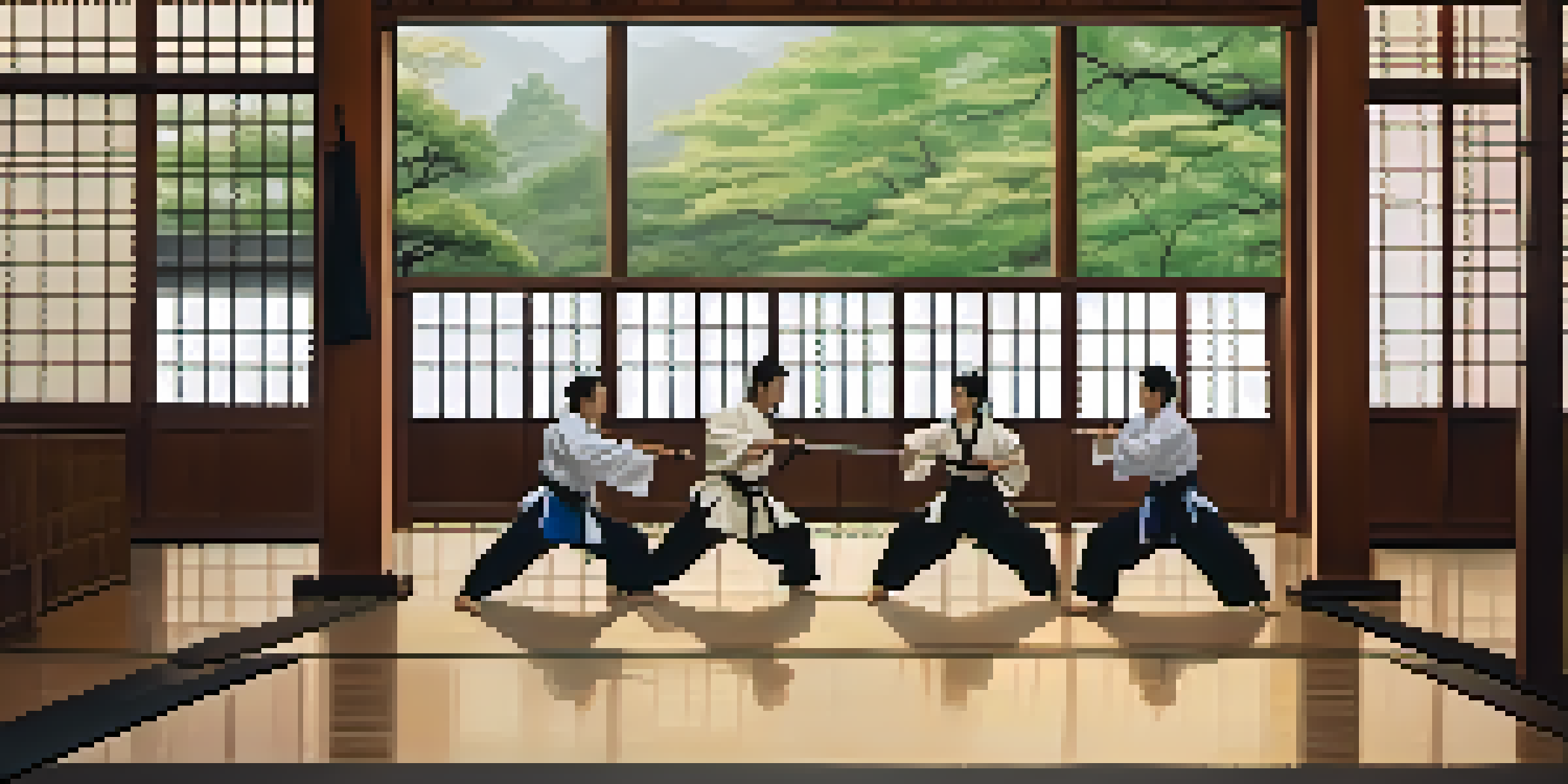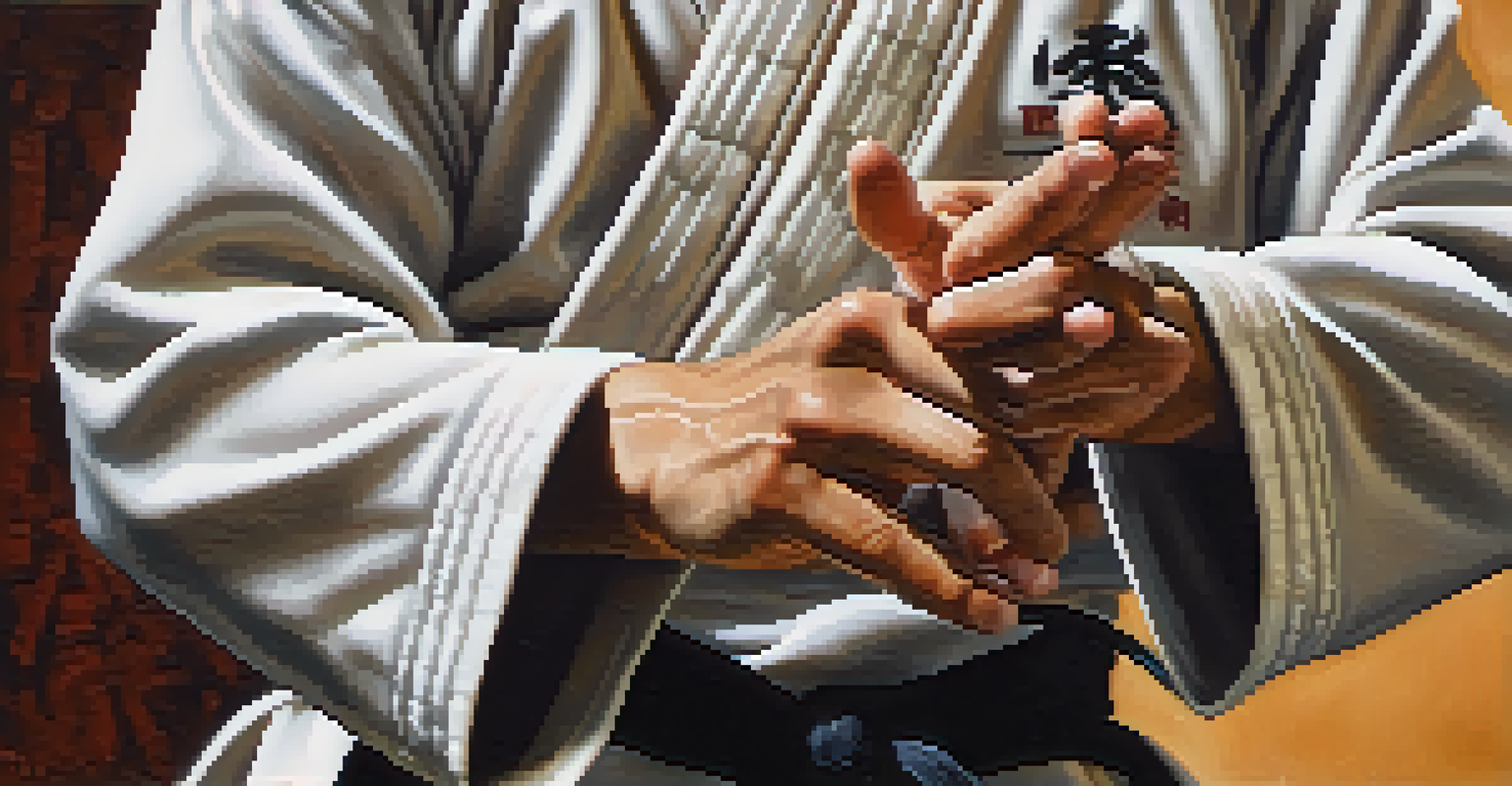Case Studies: Cultural Appropriation in Martial Arts Films

Understanding Cultural Appropriation in Martial Arts
Cultural appropriation refers to the unacknowledged or inappropriate adoption of elements from one culture by members of another culture. In martial arts films, this often manifests as Western filmmakers borrowing from Asian traditions without proper context or respect. This can lead to a distorted representation of martial arts, overshadowing the rich cultural significance they hold.
Cultural appropriation is often seen as a form of theft, where one culture takes elements from another without understanding or respecting their significance.
For instance, when a Hollywood production simplifies complex Asian philosophies into mere plot devices, it not only diminishes their depth but also risks perpetuating stereotypes. The impact is not just on the screen but also on how audiences perceive and respect these martial arts. It’s crucial to recognize that martial arts are deeply rooted in cultural narratives that deserve appreciation rather than appropriation.
The conversation around cultural appropriation in martial arts films is essential, as it raises awareness about the importance of respectful representation. Understanding this concept helps audiences critically engage with the content they consume, fostering greater respect for the cultures being portrayed.
Iconic Films and Cultural Misrepresentation
Certain martial arts films have sparked significant debate regarding cultural misrepresentation. A prominent example is 'The Last Samurai,' where a Western protagonist is placed at the center of a largely Asian narrative. While the film attempts to showcase Japanese culture, many argue it inadvertently sidelines authentic voices and perspectives.

Another film, 'Dragonball Evolution,' faced backlash for casting predominantly white actors in roles originally depicted as Asian characters. This not only enraged fans of the original series but also highlighted a broader issue of representation in Hollywood. Such choices can perpetuate harmful stereotypes and contribute to a lack of diversity in storytelling.
Cultural Appropriation in Films
Cultural appropriation in martial arts films often leads to distorted representations that overlook the rich significance of the traditions.
These films illustrate how cultural misrepresentation can shape public perception and understanding of martial arts. They remind filmmakers of the responsibility they hold in presenting cultures authentically, rather than through a lens of exoticism or reductionism.
The Role of Authentic Voices in Storytelling
In recent years, there has been a push for more authentic representation in martial arts films. This involves amplifying voices from the cultures being depicted, ensuring that the stories told are grounded in reality and respect. By doing so, filmmakers can create narratives that are not only entertaining but also educational and enriching.
Authentic representation is not just about inclusion; it’s about honoring the cultures and stories that have shaped our world.
Films like 'Warrior' and 'Crouching Tiger, Hidden Dragon' have made strides by incorporating authentic cultural elements and perspectives into their storytelling. These films celebrate martial arts as an art form while providing a platform for diverse voices. They showcase how understanding and representation can enhance the depth of the narrative.
Involving authentic voices not only strengthens the narrative but also fosters a connection between the audience and the culture represented. This approach can help dismantle stereotypes and build bridges between different communities, ultimately enriching the cinematic landscape.
Analyzing the Impact of Asian-American Filmmakers
The rise of Asian-American filmmakers has played a pivotal role in reshaping narratives within martial arts cinema. These creators bring unique perspectives that challenge traditional tropes and promote a more nuanced understanding of their cultures. Their contributions help to reclaim the narrative, offering genuine representations that resonate with audiences.
For example, films like 'Crazy Rich Asians' and 'The Farewell' have successfully integrated cultural elements without resorting to appropriation. By focusing on authentic stories, these filmmakers showcase the richness of their cultures while appealing to a broad audience. Their work emphasizes the importance of representation both in front of and behind the camera.
Importance of Authentic Voices
Incorporating authentic voices in storytelling enhances narratives and fosters a deeper connection between audiences and the cultures represented.
As the film industry evolves, the influence of Asian-American voices can lead to a more inclusive understanding of martial arts and their cultural significance. This shift can foster greater appreciation for the diversity of martial arts traditions, ultimately enriching the genre as a whole.
The Importance of Cultural Sensitivity in Filmmaking
Cultural sensitivity is crucial in filmmaking, especially in genres that draw heavily from specific cultural practices. It involves understanding the historical and social contexts of the cultures represented, allowing filmmakers to create more respectful and accurate portrayals. This awareness can significantly enhance the authenticity of martial arts films.
When filmmakers take the time to research and collaborate with cultural experts, they can avoid pitfalls of appropriation and misrepresentation. For instance, consulting martial arts practitioners or cultural historians can help ensure that the nuances of the art form are accurately depicted. This not only elevates the film's quality but also honors the traditions it seeks to portray.
Ultimately, cultural sensitivity fosters a deeper connection between the film and its audience. It encourages recognition and respect for the cultural origins of martial arts, creating a richer viewing experience that transcends mere entertainment.
Exploring Audience Perceptions and Reactions
Audience perceptions play a significant role in the discourse surrounding cultural appropriation in martial arts films. Viewers often bring their own experiences and insights to the table, influencing how they interpret the representation of cultures on screen. This dynamic can lead to varied reactions, from appreciation to criticism, depending on the authenticity of the portrayal.
For instance, films that embrace cultural authenticity tend to resonate better with audiences familiar with the traditions being depicted. Conversely, films that fall into the trap of appropriation may face backlash, as audiences demand more respect for the cultures represented. This feedback loop can encourage filmmakers to reconsider their approach to storytelling.
Impact of Asian-American Filmmakers
Asian-American filmmakers are reshaping martial arts cinema by providing nuanced representations that reclaim narratives and promote cultural understanding.
Understanding audience reactions is essential for filmmakers aiming to create impactful martial arts films. Engaging with audiences on these topics can lead to a more informed approach and ultimately help bridge cultural gaps, fostering a more inclusive cinematic experience.
The Future of Martial Arts Films and Cultural Representation
As the film industry continues to evolve, the future of martial arts films hinges on a commitment to cultural representation and sensitivity. With increasing awareness around issues of appropriation, filmmakers are more likely to prioritize authentic storytelling practices. This shift can lead to a richer tapestry of narratives that reflect the true essence of martial arts.
Emerging filmmakers from diverse backgrounds are stepping into the spotlight, bringing fresh perspectives and innovative approaches to martial arts cinema. Their stories often intertwine personal experiences with cultural elements, creating a more relatable and captivating viewing experience. This trend signifies a hopeful direction for the genre, one that embraces diversity and authenticity.

Looking ahead, the potential for martial arts films to educate and inspire is immense. By fostering respectful representation and collaboration, the industry can create a space where martial arts are celebrated not just as entertainment, but as a profound cultural expression that resonates globally.